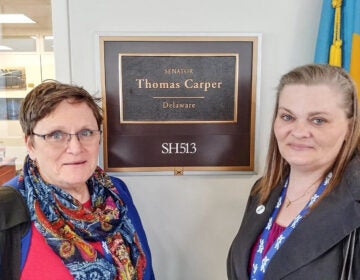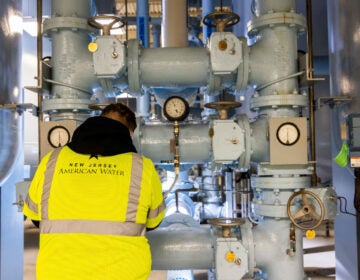Pa. proposes to relax non-residential lead cleanup standards
If approved, the lead concentration allowed on the first 2 feet of sites like the PES refinery complex would rise from 1,000 parts per million to 2,500 ppm.

Protesters gather in a parking lot at the Philadelphia Energy Solutions refinery office on Passayunk Avenue in South Philadelphia on Feb. 9, 2020. (Emma Lee/WHYY)
Pennsylvania is proposing to relax its non-residential standard for the concentration of lead allowed in the surface soils of obsolete contaminated properties adhering to its voluntary cleanup program. Such sites, like the South Philadelphia refinery complex, have potential for redevelopment as commercial or industrial ventures.
By entering into the state’s Land Recycling Program, more commonly referred to as Act 2, people or businesses agree to voluntarily clean sites up to certain standards to get liability relief. Those standards, for the concentrations of about 400 contaminants allowed to remain in the soil and groundwater, are revised at least every three years to incorporate new science and water-consumption rates.
Most of the cleanup-standard revisions proposed in February by Pennsylvania’s Environmental Quality Board, a 20-member independent committee that adopts all of the Department of Environmental Protection’s regulations, demand a more stringent remediation for owners or operators of sites polluted with toxic or carcinogenic substances including petroleum products, solvents, pesticides and others. This year, the EQB is adding new pollutants: three types of PFAS chemicals and polychlorinated biphenyls, or PCBs.
But the proposed concentration of lead allowed to remain on the first 2 feet of properties being redeveloped into non-residential projects is being increased from 1,000 parts per million to 2,500 ppm.
Christopher Ahlers, a staff attorney with the Clean Air Council, said this creates an “unreasonable risk for public health,” especially in cities with a heavy industrial past and high rates of redevelopment, like Philadelphia.
“When people have to go and clean something up, under this proposed standard, it’s much more lenient, it’s much weaker,” Ahlers said. “Maybe it means that you don’t have to do anything. Or if you have to do something, it may mean you have to clean up less than you otherwise would have to do.”
Ahlers cites the Philadelphia Energy Solutions refinery complex as an example. He said that according to a risk assessment done in 2015 by Evergreen Resources — the Energy Transfer subsidiary in charge of the cleanup of the legacy Sunoco contamination at the site before PES took it over in 2012 — two of the most heavily lead-polluted areas had 11 exceedances each, considering a lead standard of over 2,000 parts per million. If the current standard, 1,000 ppm, had been used, each area would have more than over 50 exceedances.
“It makes a big difference,” Ahlers said. “The contamination that they have to deal with is significantly greater than what Evergreen states in their report.”
According to DEP documents, the new non-residential standard was calculated using updated models from the Environmental Protection Agency. The current value was calculated using a Society of Environmental Geochemistry and Health model from 1991 and a target adult blood lead level of 20 micrograms per deciliter (µg/dL).
Instead of using an adult to determine the acceptable soil concentration, EPA’s new model, the Adult Lead Methodology from 2003, considers the potential fetus of a pregnant adult worker.
In the proposed standard revision, the Environmental Quality Board used 10 µg/dL as a target blood level. But the Centers for Disease Control and Prevention says pregnant people and children with blood lead levels of 5 µg/dL are already in danger.
EPA currently advises regional risk assessors and managers to take into consideration that “recent scientific evidence has demonstrated adverse health effects at blood lead concentrations below 10 µg/dL down to 5 µg/dL, and possibly below,” and that the agency is currently developing a new soil lead policy.
Using 5 µg/dL as a target blood level would set the lead cleanup standard at 1,050 ppm.
A lead model comparison presented to the Cleanup Standards Scientific Advisory Board, which provides science assistance to DEP and the Environmental Quality Board in developing statewide health standards, argues EPA’s guidance for the Adult Lead Methodology cautions that “the values calculated using this new model are high and may not be protective of all receptors, i.e. a school or playground that borders a non-residential property. This is not necessarily in-line with the purpose of the statewide health standard which should be protective across the entire state.”
Last year, Gov. Tom Wolf announced an initiative to keep Pennsylvania free of lead, after a statewide report found potential for harmful exposure in every county.
Why did the Environmental Quality Board choose to propose less stringent lead standards for non-residential sites? A DEP representative said the person best suited to answer that question was not available for an interview this week.
Colleen McCauley, health policy director for Public Citizens for Children and Youth, who advocates for lead-poisoning prevention, called the new standard concerning.
“Commercial and industrial sites that are allowed to have more lead on them could be contaminating homes around them, playgrounds around them, where children live and where they play, and it puts them at risk,” McCauley said.
People working at those sites could carry lead into their homes on their clothes or shoes, she said. Demolition, construction and any other soil disturbance could also affect neighbors.
An atypical attempt to regulate PFAS
In addition to updating current cleanup standards, the state Environmental Quality Board is proposing to add three new contaminants from the PFAS family that could be present in soil and groundwater: perfluorooctanoic acid (PFOA), perfluorooctane sulfonate (PFOS), and perfluorobutane sulfonate (PFBS).
PFAS, also known as “forever chemicals” because of their persistence in the environment, are a toxic class of chemicals used in firefighting foam in military bases but also in textiles, food packaging, personal care products, and cookware that is resistant to water, grease and stains. Exposure is linked to some cancers, high cholesterol and thyroid problems.
The proposed standards for these chemicals are based on toxicological studies and health advisory levels set by the EPA, which currently recommends a drinking water limit of 70 parts per trillion for PFOA and PFOS combined.
Joanne Stanton, co-founder of the Buxmont Coalition for Safer Water, welcomed the news but said it was too little, too late.
Residents of Bucks and Montgomery counties have been heavily exposed to the chemicals, which were present in firefighting foam used on former military air bases in Horsham and Warminster. The Buxmont Coalition for Safer Water has been advocating for the EPA to regulate PFAS by designating them as hazardous substance and hazardous waste, and for federal or state authorities to establish a lower maximum contaminant level for the chemicals. New Jersey has set its own maximum level at 14 parts per trillion for PFOA and 13 parts per trillion for PFOS.
“Right now, there’s nothing out there in the state, so it’s great that the EQB has proposed these amendments. At least it provides some kind of risk assessment standard that somebody can go by,” Stanton said. “But the problem is that it’s not enforceable, so it is not really doing anything to protect public health or clean water sources right now.”
Pennsylvania’s voluntary cleanup program “does not create liability for, or the obligation to, address contamination for these and other chemicals,” according to the proposed regulation.
But Harry Weiss, Ballard Spahr’s lead environmental attorney, said the proposed amendment represents an initial attempt to regulate this class of chemicals to provide those who clean up contaminated sites with some certainty with respect to continuing liability for the presence of the three chemicals.
“This regulation does not intend to call these three chemicals hazardous waste or hazardous substance, therefore, under existing statutes, some could say that this proposed regulation does not seek to make property owners liable for cleanup should any of the three chemicals be discovered on the property,” he said.
But assuming that owners or operators of polluted sites are voluntarily cleaning up to DEP’s standards to get liability relief, Weiss said, if the amendments are promulgated in some form, developers at brownfield sites may need to comply with the new rules to obtain liability relief under Act 2.
DEP has the authority to regulate what’s in — or threatens to end up in — the waters of the state, through the state’s Clean Streams Law.
According to the Environmental Quality Board, the proposed amendments will impact “owners and operators of storage tank facilities that have had a release of a petroleum or hazardous substance” — there are approximately 12,000 storage facilities in the state — and those undergoing voluntary cleanups, which on average, include 800 contaminated properties.
“The amendments to the [medium-specific concentrations, or MSCs,] in this proposed rulemaking would serve both the public and the regulated community because they would provide MSCs based on the most up-to-date health and scientific information for substances that cause cancer or have other toxic effects on human health,” reads the board’s proposed rulemaking, filed on Feb. 15.
Public comments on the proposal can be sent online or by mail to the board until April 14. The board will hold three public hearings, at 6 p.m. March 12 in Harrisburg; March 18 in Pittsburgh; and March 25 in Warminster.
WHYY is your source for fact-based, in-depth journalism and information. As a nonprofit organization, we rely on financial support from readers like you. Please give today.





